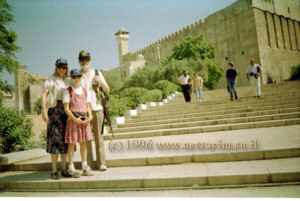Khai•yei′ Sâr•âh′ 1st Eve (Mo•tzâ•eiꞋ Shab•âtꞋ Beginning Week)

SârꞋâh Dies
SârꞋâh died in Qi•rᵊy•atꞋ ArᵊbaꞋ, a suburb on the east side of Khë•vᵊr•onꞋ, at the age of 127 years old. Avᵊrâ•hâmꞋ came to deliver the hë•sᵊpeidꞋ for her1 and to cry for her.
Avᵊrâ•hâmꞋ Purchases Mᵊâr•at′ ha-Ma•khᵊpeil•âhꞋ In Khë•vᵊr•onꞋ
 452x363.jpg) |
Then Avᵊrâ•hâmꞋ arose at municipal court, in the city gate,2 and spoke with the bᵊn•eiꞋ Kheit: "I am a geir and a to•shâvꞋ among you. Grant me a burial-estate among you so I may inter my deceased from in front of me."
The bᵊn•eiꞋ Kheit replied to Avᵊrâ•hâmꞋ: "Hearken to us, a•don•iꞋ, you are a NᵊsiꞋ Ël•oh•imꞋ among us. Take your pick of burial estates among us. None of us will withhold his burial estate from you, preventing you from interring your deceased."
Avᵊrâ•hâmꞋ had inquired into the name of the owner of a particular parcel of land. He arose and bowed to the am hâ-ÂrꞋëtz, to the bᵊn•eiꞋ Kheit: "If it's ok with your3 nëphꞋësh to inter my deceased from in front of me, hearken to me and intercede on my behalf with Ëphᵊr•onꞋ Bën-Tzo•kharꞋ that he may grant me the Mᵊâr•at′ ha-Ma•khᵊpeil•âhꞋ, at the edge of the field, which belongs to him, that he may sell it in its entirety to me for silver-coin, as a burial-estate."
 |
| Pâ•qidꞋ Yi•rᵊmᵊyâhꞋu, Karen and |
Now Ëphᵊr•onꞋ was sitting on the court amidst the bᵊn•eiꞋ Kheit and replied according to the ancient Middle Eastern tradition of negotiating. Whenever anyone admired some possession, culture demanded that the owner offer it as a magnanimous gift, in case the admirer was destitute. Those who were not destitute, or who had only admired something in passing, with no intention of possessing it, were expected to decline the magnanimous offer, so as not to take undeserved advantage of the owner's generosity. After Avᵊrâ•hâmꞋ properly declined to accept the property as a generous gift, the two negotiated on the fair market price for the entire field, including the Mᵊâr•at′ ha-Ma•khᵊpeil•âhꞋ, all of its trees and all of its boundaries. They settled on 400 silver shᵊqal•imꞋ, which Avᵊrâ•hâmꞋ paid on the spot.
So Avᵊrâ•hâmꞋ buried his wife, SârꞋâh, in Mᵊâr•at′ ha-Ma•khᵊpeil•âhꞋ, on the southeast side of Khë•vᵊr•onꞋ overlooking Ma•mᵊreiꞋ, in the land of Kᵊna•anꞋ.

Optional parental preparation:
- Note 1 – The burial practice that has passed down, presumably from the time of Avᵊrâ•hâmꞋ, requires burial within 24 hrs. The hë•sᵊpeidꞋ is delivered in the presence of the covered body of the deceased before burial. In ancient times, this was a temporary burial of one year, after which the bones were permanently interred in an ossuary. From the day of the burial, there is a 7-day period of shiv•âhꞋ during which a number of mourning practices are observed. "If a festival occurs during the mourning period, the mourning is terminated" (jewishvirtuallibrary.org/jsource/Judaism/death.html), which may explain why, in the SeiphꞋër Tor•âhꞋ, the ë in åÀìÄáÀëÌÉúÈäÌ is noticeably smaller than the other letters, perhaps to indicate that the time of crying was shortened due to one of the festivals intervening during the period of shiv•âhꞋ. From the end of shiv•âhꞋ until the 30th day after burial the mourning practices are lessened. (There is a further period of mourning for a parent, which lasts until one year after the burial.) It is imperative to be familiar with these practices to properly respect relatives who die or to visit friends in mourning.

- Note 2 – See v. 10. In ancient cities of the Middle East, the city gate was the location of the municipal courts.

- Note 3 – masc. pl.

- At a Judaic funeral, what is the hë•sᵊpeidꞋ?
- Ordinarily, within what time period should a burial to take place?
- What is the initial mourning period for an immediate relative called? (shiv•âhꞋ)
Questions you might anticipate that your child might raise and be prepared to discuss:
- What is an immediate relative?
- Where was the municipal courtroom in ancient Middle Eastern towns and cities?
- What was a burial-estate? (An estate containing the family cemetery-cave, in which the deceased would be placed in a white shroud on a flat stone. Relatives would check after 3 days to be sure they had really died and not merely been in a coma and trying to get out of the cave. After the check on the 3rd day, the deceased would be left in the cave for a year, after which the bones would be transferred to an ossuary, which would then be interred permanently in a niche of the cave.)
Google+ registered author & publisher

